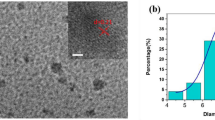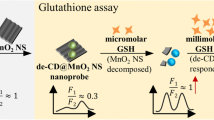Abstract
The present study shows that a dual-signal nanoprobe consisting of DNAzyme-functionalized porous carbon nanospheres (PCNs) responds to microRNA-21 and zinc ion (Zn2+). The fluorescent probe undergoes an increase in the fluorescence intensity of fluorescein isothiocyanate (FITC) (with excitation/emission wavelengths at 488/517 nm) and the fluorescence intensity of cyanine-5 (Cy5) (with excitation/emission wavelengths at 633/670 nm) in the presence of microRNA-21 and Zn2+. The recognition between microRNA-21 and its complementary strand in the PCNs induces the separation of Zn2+-specific DNAzyme from PCNs, thus resulting in the increase of green fluorescence, and the exogenous Zn2+ triggers the rupture of cleavage strand of DNAzyme and recovery of red fluorescence. This nanoprobe allows us to acquire in vitro the determination of microRNA-21 in the range of 2–300 nM with a detection limit of 0.57 nM and the determination of Zn2+ in the range 2–100 nM with a detection limit of 0.43 nM, and in situ simultaneous imaging in MCF-7 breast cancer cells. Therefore, this strategy permits to obtain the expression levels of different biomarkers in living cells, providing a useful tool for diagnosis of cancers and understanding their biological process.

Schematic representation of the DNAzyme-functionalized porous carbon nanospheres for the imaging analysis of microRNA-21 and Zn2+ in living cells.





Similar content being viewed by others

References
Montalti M, Cantelli A, Battistelli G (2015) Nanodiamonds and silicon quantum dots: ultrastable and biocompatible luminescent nanoprobes for long-term bioimaging. Chem Soc Rev 44(14):4853–4921. https://doi.org/10.1039/c4cs00486h
Wolfbeis OS (2015) An overview of nanoparticles commonly used in fluorescent bioimaging. Chem Soc Rev 44(14):4743–4768. https://doi.org/10.1039/c4cs00392f
Chen L-Y, Wang C-W, Yuan Z, Chang H-T (2014) Fluorescent gold nanoclusters: recent advances in sensing and imaging. Anal Chem 87(1):216–229. https://doi.org/10.1021/ac503636j
Ng VWK, Berti R, Lesage F, Kakkar A (2013) Gold: a versatile tool for in vivo imaging. J Mater Chem B 1(1):9–25. https://doi.org/10.1039/c2tb00020b
Baeissa A, Dave N, Smith BD, Liu J (2010) DNA-functionalized monolithic hydrogels and gold nanoparticles for colorimetric DNA detection. ACS Appl Mater Interfaces 2(12):3594–3600. https://doi.org/10.1021/am100780d
Moros M, Kyriazi ME, El-Sagheer AH, Brown T, Tortiglione C, Kanaras AG (2019) DNA-coated gold nanoparticles for the detection of mRNA in live Hydra vulgaris animals. ACS Appl Mater Interfaces 11(15):13905–13911. https://doi.org/10.1021/acsami.8b17846
Yasun E, Gulbakan B, Ocsoy I, Yuan Q, Shukoor MI, Li C, Tan W (2012) Enrichment and detection of rare proteins with aptamer-conjugated gold nanorods. Anal Chem 84(14):6008–6015. https://doi.org/10.1021/ac300806s
Kim SU, Jo EJ, Noh Y, Mun H, Ahn YD, Kim MG (2018) Adenosine triphosphate bioluminescence-based bacteria detection using targeted photothermal lysis by gold nanorods. Anal Chem 90(17):10171–10178. https://doi.org/10.1021/acs.analchem.8b00254
Xu S, Jiang L, Nie Y, Wang J, Li H, Liu Y, Wang W, Xu G, Luo X (2018) Gold nanobipyramids as dual-functional substrates for in situ “turn on” analyzing intracellular telomerase activity based on target-triggered plasmon-enhanced fluorescence. ACS Appl Mater Interfaces 10(32):26851–26858. https://doi.org/10.1021/acsami.8b05447
Martynenko IV, Litvin AP, Purcell-Milton F, Baranov AV, Fedorov AV, Gun’ko YK (2017) Application of semiconductor quantum dots in bioimaging and biosensing. J Mater Chem B 5(33):6701–6727. https://doi.org/10.1039/c7tb01425b
Kehr NS (2016) Enantiomorphous periodic mesoporous organosilica-based nanocomposite hydrogel scaffolds for cell adhesion and cell enrichment. Biomacromolecules 17(3):1117–1122. https://doi.org/10.1021/acs.biomac.5b01739
Kharkar PM, Kiick KL, Kloxin AM (2013) Designing degradable hydrogels for orthogonal control of cell microenvironments. Chem Soc Rev 42(17):7335–7372. https://doi.org/10.1039/c3cs60040h
Xue B, Kozlovskaya V, Kharlampieva E (2017) Shaped stimuli-responsive hydrogel particles: syntheses, properties and biological responses. J Mater Chem B 5(1):9–35. https://doi.org/10.1039/c6tb02746f
Lei K, Ma Q, Yu L, Ding J (2016) Functional biomedical hydrogels for in vivo imaging. J Mater Chem B 4(48):7793–7812. https://doi.org/10.1039/c6tb02019d
Lei Z, Christov N, Zhang LL, Zhao XS (2011) Mesoporous carbon nanospheres with an excellent electrocapacitive performance. J Mater Chem B 21(7):2274–2281. https://doi.org/10.1039/c0jm03322g
Wang T, Zhang P, Sun Y, Liu B, Liu Y, Qiao Z-A, Huo Q, Dai S (2017) New polymer colloidal and carbon nanospheres: stabilizing ultrasmall metal nanoparticles for solvent-free catalysis. Chem Mater 29(9):4044–4051. https://doi.org/10.1021/acs.chemmater.7b00710
Li S, Pasc A, Fierro V, Celzard A (2016) Hollow carbon spheres, synthesis and applications – a review. J Mater Chem A 4(33):12686–12713. https://doi.org/10.1039/c6ta03802f
Zhang P, Qiao ZA, Dai S (2015) Recent advances in carbon nanospheres: synthetic routes and applications. Chem Commun 51(45):9246–9256. https://doi.org/10.1039/c5cc01759a
Barnham KJ, Bush AI (2008) Metals in Alzheimer’s and Parkinson’s diseases. Curr Opin Chem Biol 12(2):222–228. https://doi.org/10.1016/j.cbpa.2008.02.019
McAllum EJ, Finkelstein DI (2016) Metals in Alzheimer’s and Parkinson’s disease: relevance to dementia with Lewy bodies. J Mol Neurosci 60(3):279–288. https://doi.org/10.1007/s12031-016-0809-5
Wu L, Guo QS, Liu YQ, Sun QJ (2015) Fluorescence resonance energy transfer-based ratiometric fluorescent probe for detection of Zn(2+) using a dual-emission silica-coated quantum dots mixture. Anal Chem 87(10):5318–5323. https://doi.org/10.1021/acs.analchem.5b00514
Xu H, Miao R, Fang Z, Zhong X (2011) Quantum dot-based “turn-on” fluorescent probe for detection of zinc and cadmium ions in aqueous media. Anal Chim Acta 687(1):82–88. https://doi.org/10.1016/j.aca.2010.12.002
Wu Q, Zhou M, Shi J, Li Q, Yang M, Zhang Z (2017) Synthesis of water-soluble Ag2S quantum dots with fluorescence in the second near-infrared window for turn-on detection of Zn (II) and cd (II). Anal Chem 89(12):6616–6623. https://doi.org/10.1021/acs.analchem.7b00777
Luo X, Wu W, Deng F, Chen D, Luo S, Au C (2014) Quantum dot-based turn-on fluorescent probe for imaging intracellular zinc (II) and cadmium (II) ions. Microchim Acta 181(11–12):1361–1367. https://doi.org/10.1007/s00604-014-1264-z
He D, He X, Yang X, Li HW (2017) A smart ZnO@polydopamine-nucleic acid nanosystem for ultrasensitive live cell mRNA imaging by the target-triggered intracellular self-assembly of active DNAzyme nanostructures. Chem Sci 8(4):2832–2840. https://doi.org/10.1039/c6sc04633a
Yang Z, Loh KY, Chu Y-T, Feng R, Satyavolu NSR, Xiong M, Nakamata Huynh SM, Hwang K, Li L, Xing H, Zhang X, Chemla YR, Gruebele M, Lu Y (2018) Optical control of metal ion probes in cells and Zebrafish using highly selective DNAzymes conjugated to upconversion nanoparticles. J Am Chem Soc 140(50):17656–17665. https://doi.org/10.1021/jacs.8b09867
Wang W, Satyavolu NSR, Wu Z, Zhang JR, Zhu JJ, Lu Y (2017) Near-infrared photothermally activated DNAzyme-gold nanoshells for imaging metal ions in living cells. Angew Chem Int Ed Eng 56(24):6798–6802. https://doi.org/10.1002/anie.201701325
Yang C, Yin X, Huan SY, Chen L, Hu XX, Xiong MY, Chen K, Zhang XB (2018) Two-photon DNAzyme-gold nanoparticle probe for imaging intracellular metal ions. Anal Chem 90(5):3118–3123. https://doi.org/10.1021/acs.analchem.7b04171
Ryan BM, Robles AI, Harris CC (2010) Genetic variation in microRNA networks: the implications for cancer research. Nat Rev Cancer 10(6):389–402. https://doi.org/10.1038/nrc2867
Tricoli JV, Jacobson JW (2007) MicroRNA: potential for cancer detection, diagnosis, and prognosis. Cancer Res 67(10):4553–4555. https://doi.org/10.1158/0008-5472.CAN-07-0563
Luo J, Xu Y, Huang J, Zhang S, Xu Q, He J (2017) Enzyme-free amplified detection of circulating microRNA by making use of DNA circuits, a DNAzyme, and a catalytic hairpin assembly. Microchim Acta 185(1):38. https://doi.org/10.1007/s00604-017-2565-9
Mahani M, Mousapour Z, Divsar F, Nomani A, Ju H (2019) A carbon dot and molecular beacon based fluorometric sensor for the cancer marker microRNA-21. Microchim Acta 186(3):132. https://doi.org/10.1007/s00604-019-3233-z
Yang L, Ren Y, Pan W, Yu Z, Tong L, Li N, Tang B (2016) Fluorescent nanocomposite for visualizing cross-talk between MicroRNA-21 and hydrogen peroxide in ischemia-reperfusion injury in live cells and in vivo. Anal Chem 88(23):11886–11891. https://doi.org/10.1021/acs.analchem.6b03701
Yi JT, Chen TT, Huo J, Chu X (2017) Nanoscale zeolitic imidazolate framework-8 for ratiometric fluorescence imaging of MicroRNA in living cells. Anal Chem 89(22):12351–12359. https://doi.org/10.1021/acs.analchem.7b03369
Wang G, Fu Y, Ren Z, Huang J, Best S, Li X, Han G (2018) Upconversion nanocrystal ‘armoured’ silica fibres with superior photoluminescence for microRNA detection. Chem Commun 54(49):6324–6327. https://doi.org/10.1039/c8cc03480j
Xia X, Hao Y, Hu S, Wang J (2014) Hairpin DNA probe with 5′-TCC/CCC-3′ overhangs for the creation of silver nanoclusters and microRNA assay. Biosens Bioelectron 51:36–39. https://doi.org/10.1016/j.bios.2013.07.036
Yang Y, Huang J, Yang X, He X, Quan K, Xie N, Ou M, Wang K (2017) Gold nanoparticle based hairpin-locked-DNAzyme probe for amplified microRNA imaging in living cells. Anal Chem 89(11):5850–5856. https://doi.org/10.1021/acs.analchem.7b00174
Wu Y, Huang J, Yang X, Yang Y, Quan K, Xie N, Li J, Ma C, Wang K (2017) Gold nanoparticle loaded split-DNAzyme probe for amplified microRNA detection in living cells. Anal Chem 89(16):8377–8383. https://doi.org/10.1021/acs.analchem.7b01632
Bin DS, Chi ZX, Li Y, Zhang K, Yang X, Sun YG, Piao JY, Cao AM, Wan LJ (2017) Controlling the compositional chemistry in single nanoparticles for functional hollow carbon nanospheres. J Am Chem Soc 139(38):13492–13498. https://doi.org/10.1021/jacs.7b07027
Wang H, Li X, Ma Z, Wang D, Wang L, Zhan J, She L, Yang F (2016) Hydrophilic mesoporous carbon nanospheres with high drug-loading efficiency for doxorubicin delivery and cancer therapy. Int J Nanomedicine 11:1793–1806. https://doi.org/10.2147/IJN.S103020
Li D, Teoh WY, Gooding JJ, Selomulya C, Amal R (2010) Functionalization strategies for protease immobilization on magnetic nanoparticles. Adv Funct Mater 20(11):1767–1777. https://doi.org/10.1002/adfm.201000188
Acknowledgments
The authors greatly acknowledge support from the Project Fund for Shangdong Key R&D Program (2017GGX20121). In addition, Xiaoting Ji particularly wishes to thank Zhan Xiao, whose sincere personality has given her powerful spiritual impetus to overcome various difficulties in her doctoral research.
Author information
Authors and Affiliations
Corresponding authors
Ethics declarations
Conflict of interest
The authors declare that they have no competing of interests.
Additional information
Publisher’s note
Springer Nature remains neutral with regard to jurisdictional claims in published maps and institutional affiliations.
Electronic supplementary material
ESM 1
(DOCX 1707 kb)
Rights and permissions
About this article
Cite this article
Ji, X., Wang, Z., Niu, S. et al. DNAzyme-functionalized porous carbon nanospheres serve as a fluorescent nanoprobe for imaging detection of microRNA-21 and zinc ion in living cells. Microchim Acta 187, 249 (2020). https://doi.org/10.1007/s00604-020-04226-6
Received:
Accepted:
Published:
DOI: https://doi.org/10.1007/s00604-020-04226-6



